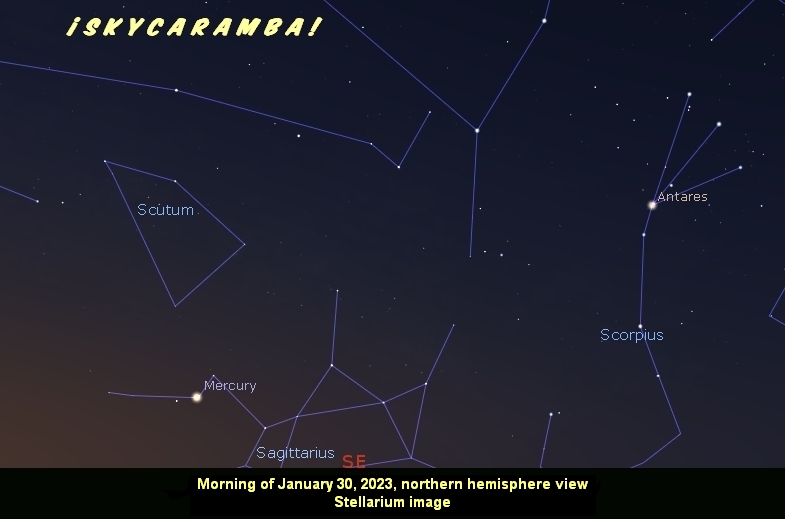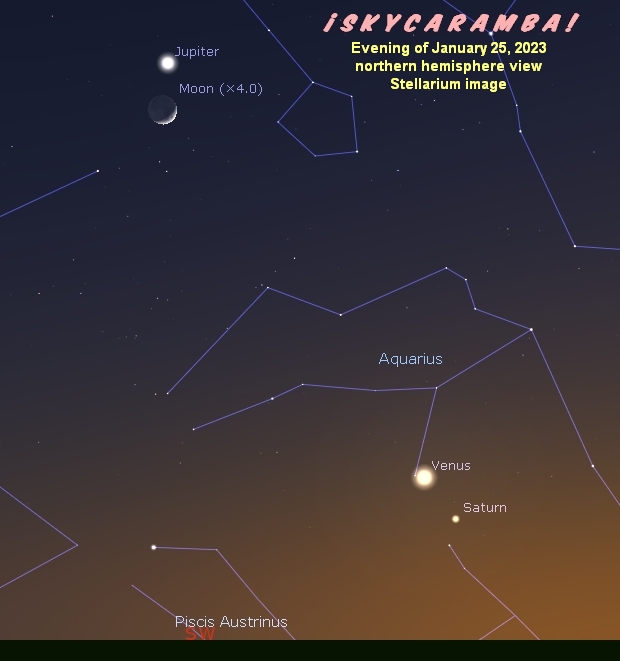
Happy New Year! 2023 starts with Mercury in retreat. After its close encounter with Venus on the last evenings of 2022, the messenger planet is sinking fast into the sunset. Depending on where you are, it may already be too late for you to see it on the first night of the year because it sets too close to sunset. If you have a clear horizon and are in a middle northern latitude, here’s a challenge for you. Look for ever bright and easily seen Venus in the southwest after sunset while there’s still a lot of light. Then use binoculars to look for Mercury below and right of it. From close to the equator, look for Venus in the west and Mercury below it.

If you can’t find Mercury in the evening this month, don’t feel bad. It’s not meant to be. The planet’s heading toward inferior conjunction on the 7th. After passing between Earth and the sun that weekend, the planet will emerge in the morning sky. Look in the east in the second half of the month as dawn’s light brightens. A thin crescent moon will be right of it on the 19th. It’s not a close conjunction. The moon’s almost 7° right of the planet. Seeing Mercury gets easier until the 30th when it’s 25° west of the sun. After that greatest elongation, it retreats sunward again.

Back to our evening sky, Venus climbs the stars of Capricornus this month as the goat-fish constellation drops into the sunset. Saturn, a slower mover, is on the higher side of Capricornus. Venus meets the ringed planet two-thirds of the way into January. They’re closest, at 0.3° separation, on the 22nd. That’s close enough for some telescopes to show you both in the same view and almost close enough to look like they’re merging into one object to the naked eye. A telescope will show you a gibbous Venus and Saturn with its northern hemisphere tilted toward us. Try to spot the very thin one-day old crescent moon close to the horizon below them that evening. The crescent will be thicker, above them, and much easier to see on the 23rd and Venus will have moved past Saturn.

By the end of the month, none of Capricornus is visible anymore. Saturn is getting hard to see so close to the horizon after sunset. But Venus is climbing the sky in the dimmer stars of Aquarius. It will have an encounter with Jupiter in about another month. For this month, Jupiter is by itself between Pisces and Cetus. The moon passes by Jupiter on the 25th. See the big planet high in the sky near the meridian (your longitude line) at sunset when January starts. It’ll be a little west of the meridian at sunset by the month’s end. Jupiter sets close to local midnight.

Mars begins 2023 retrograde (moving westward among the stars), high in the east at sunset, and marching toward the Pleiades. But it goes stationary around the 9th of January and turns away from the Seven Sisters. It will be easy to see that the red planet has resumed direct (eastward) motion by the 16th. Mars gets two visits from the moon this month. After the nearly full moon passes the Pleiades on the night of the 2nd and 3rd, it’s still not quite full when it passes Mars on the night of the 3rd to the 4th. The second moon-Mars encounter is on the 30th to 31st.


Both of this month’s close encounters between the moon and Mars will be seen as occultations somewhere. Observers in southern Africa and the western Indian Ocean will see the moon pass in front of Mars on the evening of the 3rd. The southern U.S., Central America, and far northwest South America get the event on the morning of the 31st.

All month is a good time to compare the red-orange color of Mars to that of Aldebaran in the Hyades V. The planet is a little over seven minutes of light time from us. The star’s about 66 light years away. Aldebaran looks like it’s part of the same star cluster as the rest of the Hyades. But the other stars in the V are actually 147 to 170 light years away. Aldebaran just happens to be near the line of sight to them.

Mars isn’t the only planet getting two occultations this month. Uranus will also be hidden by the moon twice and both are for far northern observers. Greenland, Iceland, and northern Europe get an event on the 1st to the 2nd overnight. Greenland gets another view in the event on the 28th to 29th. So do eastern Alaska and the Canadian islands between the Beaufort Sea and Baffin Bay. Uranus can be seen with the naked eye when the conditions are right. But with a bright moon next to it, you’ll need magnification. If you got a telescope for Christmas, this is the kind of event you can try it out on. Even if you don’t live in the occultation visibility zones, you can see the distant blue-green dot that is Uranus graze the moon or at least pass close.

This year’s Quadrantid meteor shower is challenged by the nearly full moon. The shower’s peak lasts about six hours and is centered on 2h to 3h UTC on the 4th. This is mainly a northern hemisphere shower because the point from which the meteors radiate is so far north in a part of the sky once named the Quadrant.
The moon is at northern lunistice 27.4° north of the equator on the 6th. It’s full the same day. The moon goes south of the equator on the 13th, is at last quarter on the 15th, reaches its southernmost at 27.5° from the equator on the 20th, and is new on the 21st. It goes north of the equator again on the 26th and reaches last quarter on the 28th. At its farthest from us, the moon’s apogee on the 8th is at 406,500 km or 252,600 miles. Perigee this month brings the moon not only its closest this orbit but also the closest since January 1, 2018. It’s on the 21st at 356,600 km or 221,600 miles.
Three planets are at perihelion this month! Mercury’s closest to the sun on the 2nd at 0.308 astronomical units. One astronomical unit is the average earth-sun distance. For Mercury, the perihelion distance works out to 46.1 million kilometers or 28.6 million miles. Earth’s perihelion is on the 4th at 0.983 a.u. That’s 147 million kilometers or 91.4 million miles. And Jupiter is at perihelion on the 21st at 4.951 a.u. That’s 740.7 million kilometers or 460.2 million miles.
Follow SkyCaramba on Facebook and/or Twitter for reminders about these events, more graphics, and links to more articles.
¡SkyCaramba!

Hi Sky Caramba!
Your page headed “Moon Phases” includes this:
Most people aren’t concerned with counting lunar cycles except for curiosity. However, knowing how many such cycles have passed during a given time can be important in scientific discussions about the moon’s orbit and in properly rendering religious calendars. To convert the Brown lunation number below to the Meeus number, substract 953. To obtain the Goldstine number, add 37,105. For the Islamic number, add 17,038. And for the Hebrew number, add 71,234.
The wording here suggests that 37,105 is the difference between the Goldstine number and the Brown number. But that is not correct! It’s the difference between the Goldstine number and the Meeus number.
Kind regards
Brian Gould
Thank you for bringing that to my attention. I’ve made the corrections.